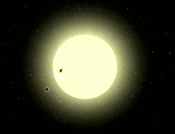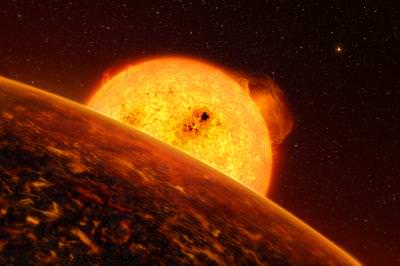[/caption]
More details are emerging on the extrasolar planet that was discovered by the CoRoT satellite back in February. New information about this planet make it first in many respects: It is the smallest known exoplanet, it is the closest exoplanet yet to its host star, which also makes it the fastest; it orbits its star at a speed of more than 750,000 kilometers per hour. Plus, data reveal the presence of twin sister planet, another so-called super-Earth called CoRot-7c in this alien solar system. Was Obi-wan wise to conceal it?
(Sorry, couldn’t resist the twin sister/Star Wars reference….)
“This is science at its thrilling and amazing best,” says Didier Queloz, leader of the team that made the observations. “We did everything we could to learn what the object discovered by the CoRoT satellite looks like and we found a unique system.”
Back in February, the team of astronomers weren’t sure if this was a rocky planet or a possibly a theoretical “ocean world.” In theory, such planets would initially be covered partially in ice and they would later drift towards their star, with the ice melting to cover it in liquid.
But the temperatures on this planet would mean whatever is on the surface of this planet is likely boiling, whether it be water or lava. The probable temperature on its “day-face” is above 2,000 degrees, but minus 200 degrees on its night face. Undoubtedly, this is an extreme environment.
The star TYC 4799-1733-1, now known as CoRot-7, and its satellites have been studied intensely since February with many telescopes on the ground. The system is located towards the constellation of Monoceros (the Unicorn) at a distance of about 500 light-years. Slightly smaller and cooler than our Sun, CoRoT-7 is also thought to be younger, with an age of about 1.5 billion years.

Every 20.4 hours, the planet eclipses a small fraction of the light of the star for a little over one hour by one part in 3,000. CoRoT-7b is only 2.5 million kilometres away from its host star, or 23 times closer than Mercury is to the Sun.
The initial set of measurements, however, could not provide the mass of the exoplanet. Such a result requires extremely precise measurements of the velocity of the star, which is pulled a tiny amount by the gravitational tug of the orbiting exoplanet. The problem with CoRoT 7b is that these tiny signals are blurred by stellar activity in the form of “starspots” (just like sunspots on our Sun), which are cooler regions on the surface of the star. Therefore, the main signal is linked to the rotation of the star, with makes one complete revolution in about 23 days.
To help look closely, astronomers used the High Accuracy Radial velocity Planet Searcher (HARPS) spectrograph attached to the ESO 3.6-metre telescope at the La Silla Observatory in Chile. This device is turning out to be one of the best planet hunters around.
“Even though HARPS is certainly unbeaten when it comes to detecting small exoplanets, the measurements of CoRoT-7b proved to be so demanding that we had to gather 70 hours of observations on the star,” said co-author François Bouchy.
HARPS delivered, allowing the astronomers to tease out the 20.4-hour signal in the data. This figure led them to infer that CoRoT-7b has a mass of about five Earth masses, placing it in rare company as one of the lightest exoplanets yet found.
“Since the planet’s orbit is aligned so that we see it crossing the face of its parent star – it is said to be transiting – we can actually measure, and not simply infer, the mass of the exoplanet, which is the smallest that has been precisely measured for an exoplanet,” says team member Claire Moutou. “Moreover, as we have both the radius and the mass, we can determine the density and get a better idea of the internal structure of this planet.”
The calculated density is close to Earth’s, suggesting that the planet’s composition is similarly rocky.
Could there be life there? Well, probably not as we know it.
“CoRoT-7b is so close [to its star] that the place may well look like Dante’s Inferno,” said Queloz. “Theoretical models suggest that the planet may have lava or boiling oceans on its surface. With such extreme conditions this planet is definitively not a place for life to develop,” says Queloz.
The sister planet, CoRoT-7c, circles its host star in 3 days and 17 hours and has a mass about eight times that of Earth, so it too is classified as a super-Earth. Unlike CoRoT-7b, this sister world does not pass in front of its star as seen from Earth, so astronomers cannot measure its radius and thus its density.
But as it stands now, CoRoT-7 is the first star known to have a planetary system made of two short period super-Earths.
Lead image caption: The exoplanet Corot-7b is so close to its Sun-like host star that it must experience extreme conditions. Sister planet, CoRot-7c is seen in the distance. Credit: ESO
Source: EurekAlert


I can’t help but wonder about not only the extremely hot temperatures on the planet, but also that tidal forces must crack its crust like an egg on a regular basis.
Actually, if the planet is that close to it’s star, I would imagine that it is tidally locked. Does anyone know if that’s the case?
With the parent star, CoRoT-7, being approximately solar size and mass, I wonder if its relative youthfulness (1.5 Gyr) might make it more “flare prone”? CoRoT-7b must already be blasted by by a fierce stellar wind so flare activity might be even more hostile to this planet. What’s the spectral type of CoRoT-7, anyway?
@Bill:
As the article states the likely surface tempurature on its “day face” exceeds 2,000 degrees, and the temp on its “night face is likely minus 200 degrees, I would guess that the planet is tidally locked. We’re getting closer to an earth-sized exoplanet….YES! This is one of my favorite aspects of astronomy.
“But as it stands now, CoRoT-7 is the first star known to have a planetary system made of two short period super-Earths.”
HD 69830 and HD 40307?
Or are you discounting these because they’re three-planet systems?
For more detailed data, the Extrasolar Planets Encyclopedia is the go-to place: http://exoplanet.eu/star.php?st=CoRoT-7
The spectral type is K0V.
The temperatures are presumably deduced on the assumption of tidal locking and no atmosphere, not measured. Interesting to speculate what kind of atmosphere there might be, e.g. vapourised rock.
Well it is 5 times bigger than earth, with solid surface and chances are that has a hot core. So it has stronger gravity to hold boiled oceans on the surface and stronger magnetic field to resist solar wind from blasting its atmosphere. Were these things looked at too? Maybe there is a possibility that there is atmosphere there.